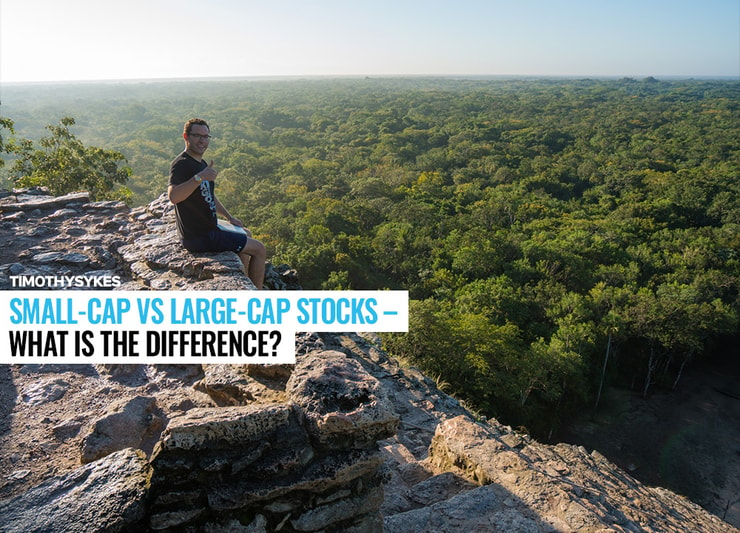In the world of trading, you’ll often hear terms like “small-cap” and “large-cap.” These terms refer to a company’s market capitalization, or market cap, which is the total market value of a company’s outstanding shares of stock.
In life and business, most people want to think big. But in the stock market, sometimes it pays to think small.
If your portfolios are filled with large-cap stocks, you may profit over time … But that can take months or even years.
If you aren’t content to wait, consider trading stocks with more volatility. Small-cap stocks can offer greater (and quicker) returns. But you have to manage your risk, trade with a plan, and stay disciplined.
I’ve been teaching small-cap strategies for over a decade, and I’ve seen a lot of examples of them working. But in my experience, the answer is different for every trader…
What’s the difference between small-cap and large-cap stocks, and how does this information impact your trading strategy? Let’s break it down.
Table of Contents
- 1 What Is the Difference between the Two Types of Stocks
- 2 What Are Small-Cap Stocks?
- 3 What Are Large-Cap Stocks?
- 4 Track Record of Small-Cap vs. Large-Cap Companies
- 5 Risk Considerations for Investing in Small-Cap or Large-Cap Companies
- 6 Investment Strategies for Investing in Small or Large Caps
- 7 Market Indices that Track Small and Large-cap Stocks
- 8 Which Should You Choose for Your Portfolio?
- 9 Key Takeaways
What Is the Difference between the Two Types of Stocks

The main difference between small-cap and large-cap stocks lies in the size of the companies they represent. Small-cap stocks are shares of companies with a market capitalization between $250 million and $2 billion. These companies are often younger or operate in niche markets, and they offer high growth potential but also carry a higher risk.
On the other hand, large-cap stocks represent companies with a market capitalization of more than $10 billion. These are typically well-established companies in the market, and while their growth may not be as explosive as small-cap stocks, they often provide more stability and regular dividends.
What Are Small-Cap Stocks?
Small-cap stocks represent smaller companies that have a cap number between $250 million and $2 billion. These companies might be in the early stages of growth or operate in emerging industries.
Trading small-cap stocks can offer high growth potential. However, with this potential for high returns comes a higher level of risk. These stocks can be more volatile and less liquid than large-cap stocks.
That said, I still think small-cap stocks (and even micro-caps) are the best way to build a small account. Check this out:
While small-cap stocks can offer high growth potential, it’s important to remember that they can also carry a higher level of risk. This is due to their size and the industries they operate in. However, the potential for growth can be enticing for those willing to take on the risk. If you’re interested in learning more about how to navigate the world of small-cap stocks, you might find this guide on investing in large-cap stocks helpful. It provides a comprehensive overview of the strategies and considerations involved in investing in these types of stocks.
What Are Large-Cap Stocks?
Large-cap stocks are shares of companies with a market capitalization of over $10 billion. These companies are often household names with a long history and stable earnings. They are typically more stable and less volatile than small-cap stocks, making them a popular choice for conservative investors.
Large-cap stocks are often seen as more stable investment options due to their size and established presence in the market. They can offer regular dividends and are generally less volatile than their small-cap counterparts. However, it’s important to remember that investing in large-cap stocks still requires careful consideration and strategy. For a deeper understanding of this type of investment, consider exploring this guide on investing in blue-chip stocks. It provides valuable insights into the world of blue-chip stocks, which are often considered the cream of the crop in the large-cap category.
Growth Potential
Large-cap companies often have slower growth compared to small-cap companies. However, they are generally considered more stable and less risky.
Financial Resources
Large-cap companies usually have more financial resources, which can help them weather downturns in the market or invest in new opportunities.
More Breaking News
- VSee Health Inc. Spark: Can This Growth Continue?
- iRhythm’s Skyward Surge: What’s Behind the 17% Stock Leap?
- Can Verizon Overcome Challenges and Shine Bright Again?
Volatility
Large-cap stocks are typically less volatile than small-cap stocks. This means their share prices don’t fluctuate as dramatically, which can be appealing to risk-averse investors.
Dividends
Large-cap companies are more likely to pay dividends to their shareholders. These regular payments can provide a steady income stream for investors.
Business Strength
Large-cap companies often have a strong market presence and competitive advantages, such as brand recognition or a large customer base.
Track Record of Small-Cap vs. Large-Cap Companies

When comparing the track record of small-cap vs. large-cap companies, it’s important to consider both performance over time and historical returns.
Performance Analysis Over Time
Over time, small-cap stocks have tended to outperform large-cap stocks. This is largely due to their high growth potential. However, this isn’t always the case, and the performance of small-cap vs. large-cap stocks can vary depending on the market conditions.
Historical Returns of Small Cap vs. Large Cap Companies
Historically, small-cap stocks have provided higher returns than large-cap stocks. However, these higher returns come with higher volatility and risk.
Also: past performance is not a guarantee of future results!
Risk Considerations for Investing in Small-Cap or Large-Cap Companies
When trading either small-cap or large-cap stocks, it’s crucial to consider your risk tolerance.
Volatility and Risk Tolerance
Small-cap stocks are generally more volatile than large-cap stocks. This means they can provide higher returns, but they can also have greater risks.
Risk tolerance is different for every trader — it’s important to consider your own risk tolerance when deciding to trade small-cap stocks.
Diversification Strategies for Small-Caps and Large Caps
Diversification is one strategy for managing risk. By trading a mix of small-cap and large-cap stocks, you can balance the high growth potential of small-cap stocks with the stability of large-cap stocks.
You can also diversify between sectors. Take a look at my top consumer discretionary stocks to watch to see how it compares with your watchlists!
Investment Strategies for Investing in Small or Large Caps

When it comes to investing in small-cap or large-cap stocks, it’s important to choose an investment strategy that aligns with your financial goals and risk tolerance.
Note well: I only trade stocks. But it’s your money.
This isn’t a recommendation, it’s just an FYI.
Choosing an Investment Strategy
Your investment strategy should take into account your financial goals, risk tolerance, and investment timeline. You might choose to focus on small-cap stocks if you’re looking for high growth potential and are willing to take on more risk.
On the other hand, you might prefer large-cap stocks if you’re looking for stability and regular dividends.
Creating Your Own Portfolio
When creating your own portfolio, it’s important to diversify your investments. This means investing in a mix of small-cap and large-cap stocks, as well as other asset classes like bonds or ETFs.
Mutual Funds that Offer Exposure to Both Asset Classes
If you’re looking to invest in both small-cap and large-cap stocks, consider a mutual fund that offers exposure to both asset classes. These funds can provide diversification and professional management.
Market Indices that Track Small and Large-cap Stocks

Market indices provide a snapshot of the performance of a specific group of stocks. They can be a useful tool for tracking the performance of small-cap and large-cap stocks.
Russell 1000 Index
The Russell 1000 Index is a market-capitalization-weighted index of the 1000 largest publicly traded companies in the U.S. It represents approximately 92% of the total U.S. stock market and is a good barometer for the performance of large-cap stocks.
Other Popular Indices to Track the Performance of Both Types of Companies
There are several other indices that track the performance of both small-cap and large-cap stocks. The S&P 500 Index tracks the performance of 500 large-cap companies, while the Russell 2000 Index tracks the performance of 2000 small-cap companies. These indices can provide a useful benchmark for comparing the performance of your own investments.
Which Should You Choose for Your Portfolio?
The choice between small-cap and large-cap stocks depends on your individual investment goals, risk tolerance, and investment horizon. If you’re looking for high growth potential and are willing to take on more risk, you might lean towards small-cap stocks. On the other hand, if you’re looking for more stability and regular dividends, you might prefer large-cap stocks. Diversifying your portfolio with a mix of both can help balance risk and reward.
Key Takeaways

Choosing between small-cap and large-cap stocks depends on your trading goals, risk tolerance, and trading strategy. Small-cap stocks offer high growth potential but come with increased risk and volatility. On the other hand, large-cap stocks provide more stability but may not offer the same level of growth.
Trading isn’t rocket science. It’s a skill you build and work on like in other careers — with much greater compensation possible. No matter the goals you have in mind, smart trading can help you get there. Trading has changed my life, and I think this way of life should be open to more people…
I’ve built my Trading Challenge to pass on the things I had to learn for myself. It’s the kind of place that I wish I had when I was starting out.
We don’t accept everyone. If you’re up for the challenge — I want to hear from you.
Apply to the Trading Challenge here.
Trading is a battlefield. The more knowledge you have, the better prepared you’ll be.
Do you prefer to trade small- or large-cap stocks? Let me know in the comments — I love hearing from my readers!





Leave a reply